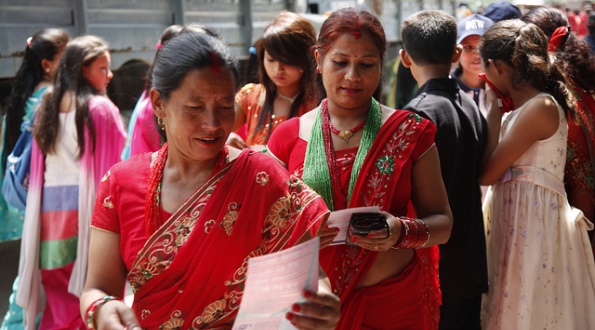BECOME A MEMBER
>JOIN
In Nepal, Women Fight to Maintain Seats in the Constituent Assembly

In Nepal, women fight to maintain their seast in the Constituent Assembly, reports the National Democratic Institute (NDI) that is supporting them in ther struggle.
Nepali women had much to be proud of as 172 of them were seated in the country’s newest Constituent Assembly on Jan. 22. They filled almost 30 percent of the 575 seats that were contested during parliamentary elections last fall, despite an earlier decision by a group of party elders to reduce the size of the assembly to 495 seats. A smaller assembly would have decreased the quota for women by 66 seats to 22 percent.
In addition to traditional lawmaking, this Constituent Assembly is also tasked with drafting Nepal’s new constitution, making the presence of the women especially important.
When legislative elections were held in 2008, the country had a quota guaranteeing that 33 percent of the assembly’s seats would go to women. But for the 2013 polls, the High Level Political Committee (HLPC), an eight-person council of political party leaders, put the reduction in place.
Nevertheless, thanks to a pre-election advocacy campaign, Nepali women were able to exceed the quota and preserve most of their parliamentary seats.
In the months leading up to the elections, NDI and four Nepali civic organizations formed the Committee for 33 Percent Women to help women advocate for parliamentary representation.
The committee produced radio and television advertisements about the need for more women in government to make it more reflective of society. […]
When political party candidate lists became final on Oct. 5, the Committee for 33 Percent Women supported the campaigns of the 646 women who ran under the first-past-the-post (FPTP) system — in which seats are won by the candidate who receives the most votes — in their respective districts. The Committee placed full-page ads in two national newspapers, listing the names and party affiliations of all 646 women.
In Nepal’s mixed electoral system, 240 candidates are elected under FPTP and 335 are selected from party lists under a proportional representation system. The other 26 members are appointed.
NDI and Democracy and Elections Watch (DEW-Nepal), a citizen election monitoring organization, worked [through different events and campaigns] to ensure that women voted in November.
NDI conducted two training programs for women parliamentary candidates in September. Held in Kathmandu and Pokhara, the sessions focused on developing leadership skills and effective campaign practices, such as recruiting and retaining volunteers, targeting women and youth voters, and creating campaign plans. More than 90 women participated in the two sessions, representing nine political parties and all five regions of Nepal.
Of the women elected to the Constituent Assembly, 27 participated in NDI programs, including campaign seminars, community dialogues and the Kathmandu and Pokhara training programs.
NDI’s programming is funded by the U.S. Agency for International Development and the U.S. Department of State’s Bureau of Democracy, Human Rights, and Labor.
To read the entire article, please visit the NDI homepage.
Photo by National Democratic Institute.

